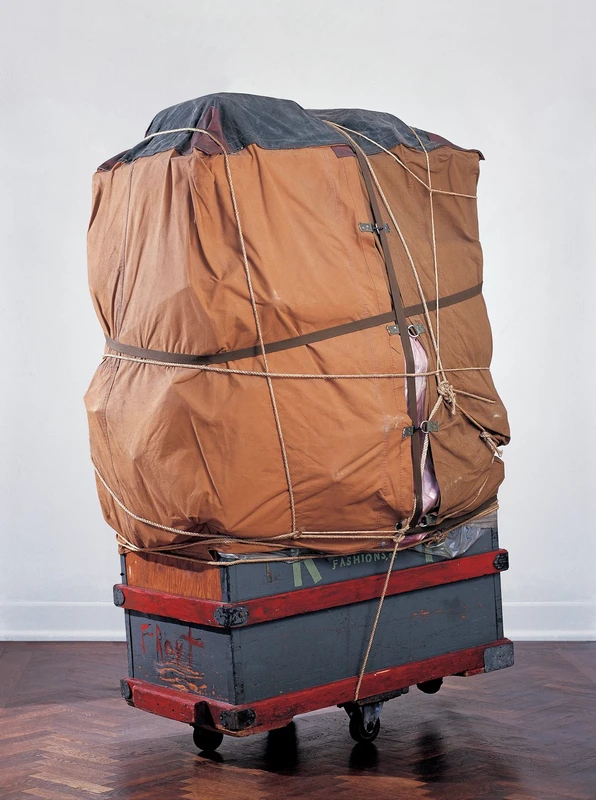Christo


b. 1935, United States
d. 2020
In monumental sculptures produced and installed in public sites around the world, Christo and Jeanne-Claude expanded the possibilities of artistic scale and dramatically—but temporarily—transformed familiar landscapes. Employing fabric, rope, barrels, and other commonplace materials to visually alter both urban and rural spaces, their works created shared experiences across the globe. Often requiring many years of planning and negotiation, these projects exist only for a few days to a few weeks, after which their materials are recycled or reused and the sites are restored to their original state. Christo worked collaboratively with his wife Jeanne-Claude from 1961 until her death in 2009.
Christo Vladimirov Javacheff was born in 1935 in Gabrovo, Bulgaria. He studied under the Communist regime at the National Academy of Art, Sofia, from 1952 to 1956. His escape to the West took him through Prague and Vienna, where he spent one semester at the Academy of Fine Arts before relocating to Geneva and then Paris. He arrived in the city in 1958, and met Jeanne-Claude Denat de Guillebon (born on the same day as Christo in Casablanca, Morocco), who became not only his wife but his life partner in the creation of monumental environmental works of art. The couple had a son in 1960 and moved to New York four years later.
Christo’s early works—assemblages of found objects such as cans, bicycles, and road signs—were inspired by the blurring of boundaries between art and environment in works of Nouveau Réalisme by artists such as Jean Tinguely and Yves Klein. Surfaces d’Empaquetage (1958–61), Christo’s first artistic experiments, are composed of crumpled sheets of fabric or paper coated with lacquer and sand, while Cratères (1959–60) feature highly textured reliefs made from paint, glue, and sand. His Store Fronts series (1964–68) incorporated salvaged architectural elements resembling shop windows, their glass panels covered with paper or fabric to obstruct the view inside. Most of Christo’s first Wrapped Objects (1958–69) comprise art materials swathed in resin-soaked canvas; others employ fabric or polyethylene bound with rope, which alternately reveal and conceal the items’ identities.
Christo began collaborating with Jeanne-Claude on Stacked Oil Barrels and Dockside Packages, Cologne Harbor (1961), an outdoor work installed by the Rhine River. In 1962, the couple erected Wall of Oil Barrels—The Iron Curtain, Rue Visconti, Paris, 1961–62, a barricade that blocked the titular street for eight hours to protest the construction of the Berlin Wall. In 1968, they participated in documenta IV in Kassel with 5,600 Cubicmeter Package, documenta IV, Kassel, 1967–68, a 280-foot-tall inflatable fabric structure, while Wrapped Kunsthalle, Bern, Switzerland, 1967–68, made using 26,000 square feet of reinforced polyethylene, marked their first wrapping of an entire building. In Wrapped Coast, One Million Square Feet, Little Bay, Sydney, Australia, 1968–69, they covered a mile and a half of rocky cliffs.
From the 1970s onward, Christo and Jeanne-Claude expanded their projects’ scale and complexity. For Running Fence, Sonoma and Marin Counties, California, 1972–76, they installed 18-foot-tall nylon panels that extended 24 1/2 miles through the hills of Northern California to the Pacific Ocean. To realize Surrounded Islands, Biscayne Bay, Greater Miami, Florida, 1980–83, they collaborated with 430 workers to delimit eleven uninhabited islands with 6.5 million square feet of pink woven polypropylene fabric. The Gates, Central Park, New York City, 1979–2005, an installation of 7,503 saffron-colored vinyl gates with free-hanging fabric panels, took twenty-six years and $21 million to realize, and generated enormous public interest.
The London Mastaba, Serpentine Lake, Hyde Park, 2016–18, a stack of 7,506 barrels arrayed on a floating platform in Serpentine Lake, was Christo’s first major public outdoor work in the United Kingdom. It presaged The Mastaba, Project for United Arab Emirates, a planned work that will be Christo and Jeanne-Claude’s only permanent large-scale structure. Following Christo’s death in New York in 2020 and per his wishes, L’Arc de Triomphe Wrapped, Paris, 1961–2021 was posthumously realized in Paris as an homage to both artists.